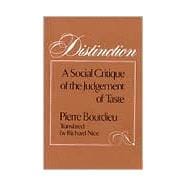
Note: Supplemental materials are not guaranteed with Rental or Used book purchases.
Purchase Benefits
What is included with this book?
| Preface to the English-Language Edition | p. xi |
| Introduction | p. 1 |
| A Social Critique of the Judgement of Taste | p. 9 |
| The Aristocracy of Culture | p. 11 |
| The Titles of Cultural Nobility | p. 18 |
| Cultural Pedigree | p. 63 |
| The Economy of Practices | p. 97 |
| The Social Space and Its Transformations | p. 99 |
| Class Condition and Social Conditioning | p. 101 |
| A Three-Dimensional Space | p. 114 |
| Reconversion Strategies | p. 125 |
| The Habitus and the Space of Life-Styles | p. 169 |
| The Homology between the Spaces | p. 175 |
| The Universes of Stylistic Possibles | p. 208 |
| The Dynamics of the Fields | p. 226 |
| The Correspondence between Goods Production and Taste Production | p. 230 |
| Symbolic Struggles | p. 244 |
| Class Tastes and Life-Styles | p. 257 |
| The Sense of Distinction | p. 260 |
| The Modes of Appropriation of the Work of Art | p. 267 |
| The Variants of the Dominant Taste | p. 283 |
| The Mark of Time | p. 295 |
| Temporal and Spiritual Powers | p. 315 |
| Cultural Goodwill | p. 318 |
| Knowledge and Recognition | p. 319 |
| Education and the Autodidact | p. 328 |
| Slope and Thrust | p. 331 |
| The Variants of Petit-Bourgeois Taste | p. 339 |
| The Declining Petite Bourgeoisie | p. 346 |
| The Executant Petite Bourgeoisie | p. 351 |
| The New Petite Bourgeoisie | p. 354 |
| From Duty to the Fun Ethic | p. 365 |
| The Choice of the Necessary | p. 372 |
| The Taste for Necessity and the Principle of Conformity | p. 374 |
| The Effects of Domination | p. 386 |
| Culture and Politics | p. 397 |
| Selective Democracy | p. 399 |
| Status and Competence | p. 405 |
| The Right to Speak | p. 411 |
| Personal Opinion | p. 414 |
| The Modes of Production of Opinion | p. 417 |
| Dispossession and Misappropriation | p. 426 |
| Moral Order and Political Order | p. 432 |
| Class Habitus and Political Opinions | p. 437 |
| Supply and Demand | p. 440 |
| The Political Space | p. 451 |
| The Specific Effect of Trajectory | p. 453 |
| Political Language | p. 459 |
| Conclusion: Classes and Classifications | p. 466 |
| Embodied Social Structures | p. 467 |
| Knowledge without Concepts | p. 470 |
| Advantageous Attributions | p. 475 |
| The Classification Struggle | p. 479 |
| The Reality of Representation and the Representation of Reality | p. 482 |
| Postscript: Towards a 'Vulgar' Critique of 'Pure' Critiques | p. 485 |
| Disgust at the 'Facile' | p. 486 |
| The 'Taste of Reflection' and the 'Taste of Sense' | p. 488 |
| A Denied Social Relationship | p. 491 |
| Parerga and Paralipomena | p. 494 |
| The Pleasure of the Text | p. 498 |
| Appendices | p. 503 |
| Some Reflections on the Method | p. 503 |
| Complementary Sources | p. 519 |
| Statistical Data | p. 525 |
| Associations: A Parlour Game | p. 546 |
| Notes | p. 561 |
| Credits | p. 605 |
| Index | p. 607 |
| Tables | |
| Class preferences for singers and music | p. 15 |
| Aesthetic disposition, by education capital | p. 36 |
| Aesthetic disposition, by class and education | p. 37 |
| Knowledge of composers and musical works, by education and class of origin | p. 64 |
| Furniture purchases in the dominant class, by education and social origin | p. 78 |
| Some indicators of economic capital in different fractions of the dominant class, 1966 | p. 117 |
| Some indicators of cultural practice in different fractions of the dominant class, 1966 | p. 118 |
| Types of books preferred by different fractions of the dominant class, 1966 | p. 119 |
| Social origin of members of the dominant class, by class fraction, 1970 | p. 121 |
| Rate of employment of women aged 25-34, by education, 1962 and 1968 | p. 134 |
| Changes in morphology and asset structure of the class fractions, 1954-1975 | p. 136 |
| Changes in morphology and asset structure of the class fractions, 1954-1968 | p. 138 |
| Morphological changes within the dominant class, 1954-1975 | p. 140 |
| Morphological changes within the middle class, 1954-1975 | p. 140 |
| Changes in class morphology and use of educational system, 1954-1968 | p. 158 |
| Annual household expenditures on food: skilled manual workers, foremen and clerical workers, 1972 | p. 181 |
| Yearly spending by teachers, professionals and industrial and commercial employers, 1972 | p. 184 |
| Table of Contents provided by Rittenhouse. All Rights Reserved. |
The New copy of this book will include any supplemental materials advertised. Please check the title of the book to determine if it should include any access cards, study guides, lab manuals, CDs, etc.
The Used, Rental and eBook copies of this book are not guaranteed to include any supplemental materials. Typically, only the book itself is included. This is true even if the title states it includes any access cards, study guides, lab manuals, CDs, etc.